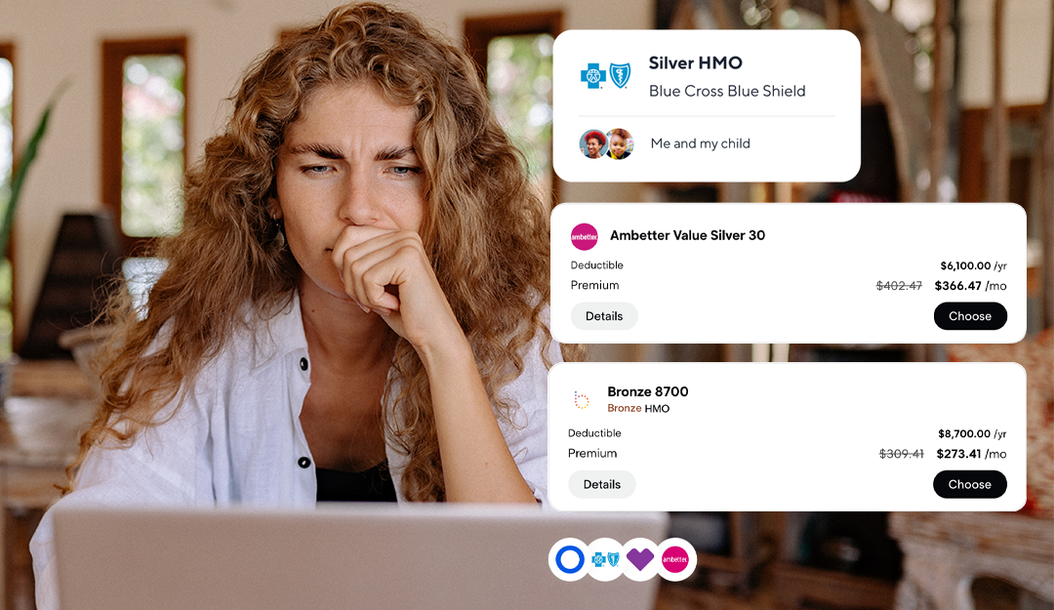Choosing the right health plan often comes down to the type of coverage you need. Here, two questions are important: what are your preferences in terms of costs, e.g. how much would you like to pay upfront vs. later, and the types of doctors you’d like to see, e.g. ones you get to pick vs. not? Below, we detail both to help you pick the best plan for your specific needs.
How much do I want to pay upfront?
Plans are categorized by “metal tiers” that indicate the average amount of health care costs covered under the plan.
Bronze plans have the lowest monthly premiums, but the highest costs when you need care. These plans are a good choice if you want a low-cost way to protect yourself from worst-case medical scenarios, like serious sickness or injury.
Silver plans have moderate monthly premiums and moderate costs when you need care. These plans are best if you’re willing to pay slightly more per month to have more of your routine care covered.
Gold plans have high monthly premiums but low costs when you need care. These are a better option than Bronze or Silver if you use a lot of care or are willing to spend more just for peace of mind.
Platinum plans have the highest monthly premiums, but the lowest costs when you get care. These plans are best if you anticipate using a lot of care and are willing to pay more per month to cover most costs when you receive care.
How much flexibility do I want in choosing my doctors?
Whenever you need care, you can choose your doctor. You can choose between an in-network doctor, or an out-of-network doctor. When you see an in-network doctor, you get in-network coverage and typically lower costs. When you visit an out-of-network doctor, you might have more flexibility in choice, but your costs might be higher or not covered at all.
Depending on the health insurance plan you choose, your plan may or may not require you to choose doctors within a certain network in order to pay for your coverage. Below you’ll find descriptions of the different types of plans you can choose.
HMO (Health Maintenance Organization plans): HMO plans give you access to certain doctors and hospitals within a specific network, and care is only covered if you see a provider within that HMO’s network. Generally, this plan won't cover out-of-network care unless for emergencies. The average premium for an HMO is around $480/month.
PPO (Preferred Provider Organization plans): This is currently still the most popular plan of choice for the masses. PPOs tend to have higher premiums than an HMO or a POS, but with a PPO you can access specialists and out-of-network doctors without a referral. Additionally, costs for copays and coinsurance tend to be lower for in-network doctors. Essentially, you pay less money to use providers that are already in the plan’s network. he average PPO premium is around $560/month.
EPO (Exclusive provider organization plans): An EPO is a managed care plan where services are covered only if you use doctors, specialists, or hospitals in the plan’s network, except in the case of an emergency. Often, EPOs do not provide coverage for services outside of the EPO network, so it’s important to check which providers are in the network! The average monthly premium for an EPO is $490.
POS (Point-of-service plans): This is basically a combo of the traditional HMO and PPO plan. You’re able to see any provider within a large network and choose a primary care provider. You are also free to use specialists that might be out-of-network, but will more than likely pay higher amounts to do so. The average premium for a POS plan is about $510.
HDHPs (High-deductible health plans): HDHPs mean you pay a lower monthly premium but have a higher deductible to reach before insurance steps in. To help offset out-of-pocket costs, qualified HDHPs are often paired with a health savings account (HSA) in which you can put in money tax-free, grow it tax-free through investments, and take out money tax-free to pay for qualified medical expenses. You can expect to pay about $405/month for your premium. Please note: An HDHP can come in the form of an HMO, PPO, POS or EPO. It simply relies on the deductible to determine its status as an HDHP. For anyone who might need a lot of care but can’t afford higher monthly premiums, HDHPs provide an opportunity to save money in the long run.
Catch can help guide you to the most affordable options, fast. In less than 60 seconds, we’ll show you which plans are available to you and recommend the best plan for your needs. Get started with our health explorer today.

